Whitbread Plc: Strategic Management Report for Hospitality Business
VerifiedAdded on 2022/11/28
|12
|3805
|247
Report
AI Summary
This report provides a comprehensive strategic analysis of Whitbread Plc., a major player in the hospitality industry. It begins with an introduction to strategic management and its importance, followed by a stakeholder analysis identifying key internal and external groups. Part A delves into the external environment using PESTLE analysis, examining political, economic, social, technological, legal, and environmental factors. It also analyzes the internal environment through a SWOT analysis, evaluating the company's strengths, weaknesses, opportunities, and threats. Furthermore, it utilizes Porter's Five Forces model to assess competitive forces within the industry. Part B evaluates strategic directions, employing Bowman's Strategy Clock to understand competitive positioning and the Ansoff Growth Matrix to explore market growth strategies. The report concludes with a strategic management plan, offering recommendations for Whitbread Plc.'s future success in the dynamic hospitality market.
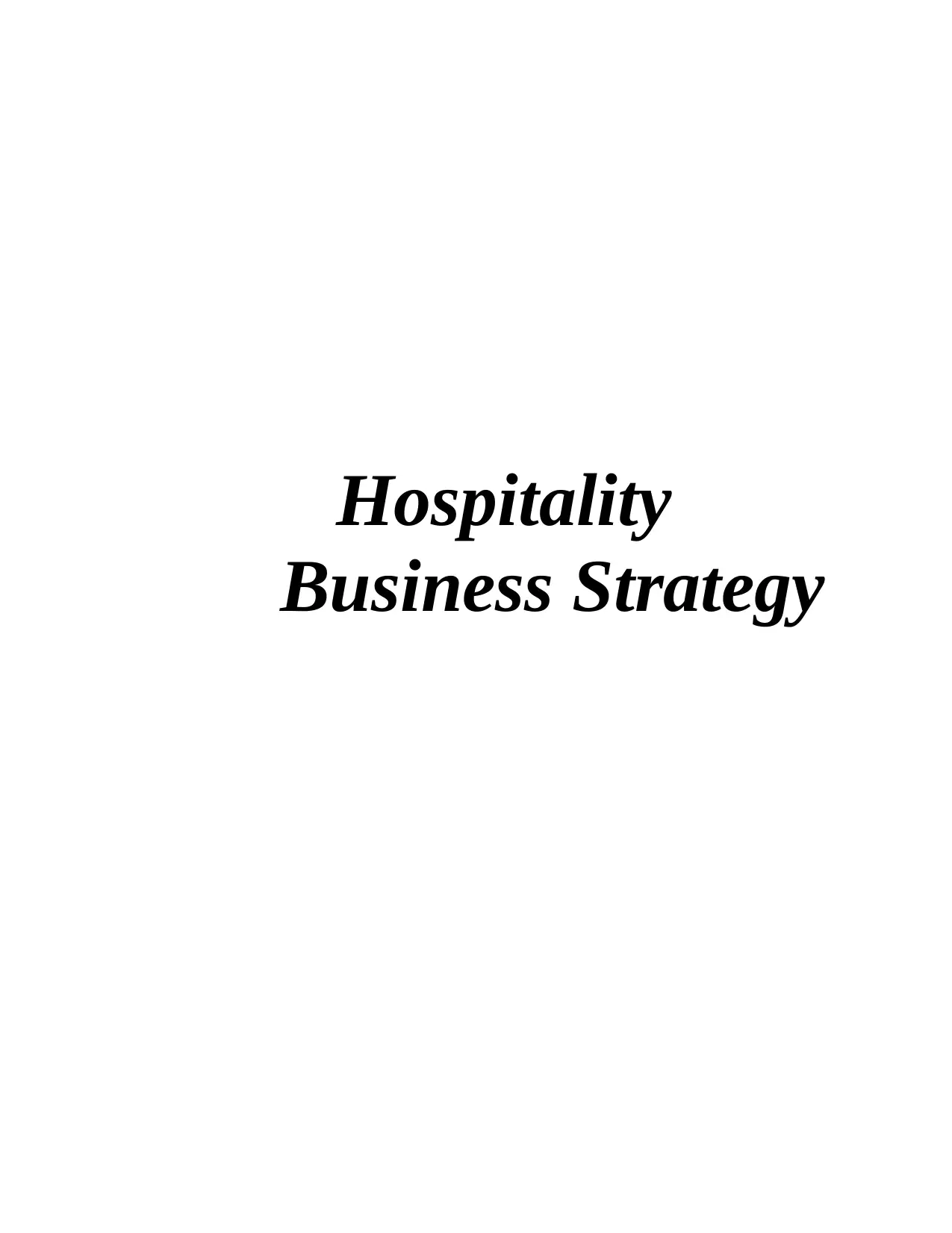
Hospitality
Business Strategy
Business Strategy
Paraphrase This Document
Need a fresh take? Get an instant paraphrase of this document with our AI Paraphraser
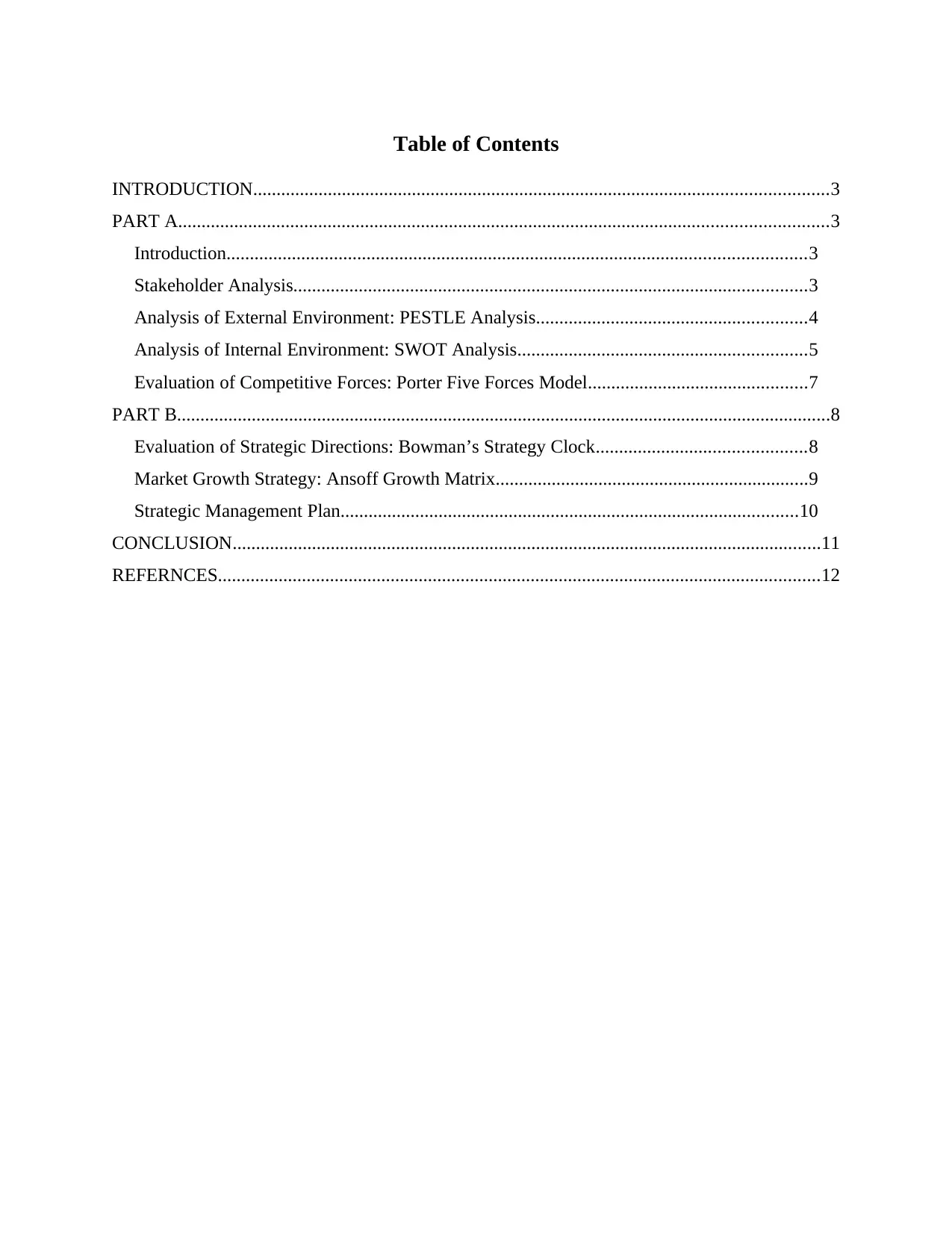
Table of Contents
INTRODUCTION...........................................................................................................................3
PART A...........................................................................................................................................3
Introduction............................................................................................................................3
Stakeholder Analysis..............................................................................................................3
Analysis of External Environment: PESTLE Analysis..........................................................4
Analysis of Internal Environment: SWOT Analysis..............................................................5
Evaluation of Competitive Forces: Porter Five Forces Model...............................................7
PART B............................................................................................................................................8
Evaluation of Strategic Directions: Bowman’s Strategy Clock.............................................8
Market Growth Strategy: Ansoff Growth Matrix...................................................................9
Strategic Management Plan..................................................................................................10
CONCLUSION..............................................................................................................................11
REFERNCES.................................................................................................................................12
INTRODUCTION...........................................................................................................................3
PART A...........................................................................................................................................3
Introduction............................................................................................................................3
Stakeholder Analysis..............................................................................................................3
Analysis of External Environment: PESTLE Analysis..........................................................4
Analysis of Internal Environment: SWOT Analysis..............................................................5
Evaluation of Competitive Forces: Porter Five Forces Model...............................................7
PART B............................................................................................................................................8
Evaluation of Strategic Directions: Bowman’s Strategy Clock.............................................8
Market Growth Strategy: Ansoff Growth Matrix...................................................................9
Strategic Management Plan..................................................................................................10
CONCLUSION..............................................................................................................................11
REFERNCES.................................................................................................................................12
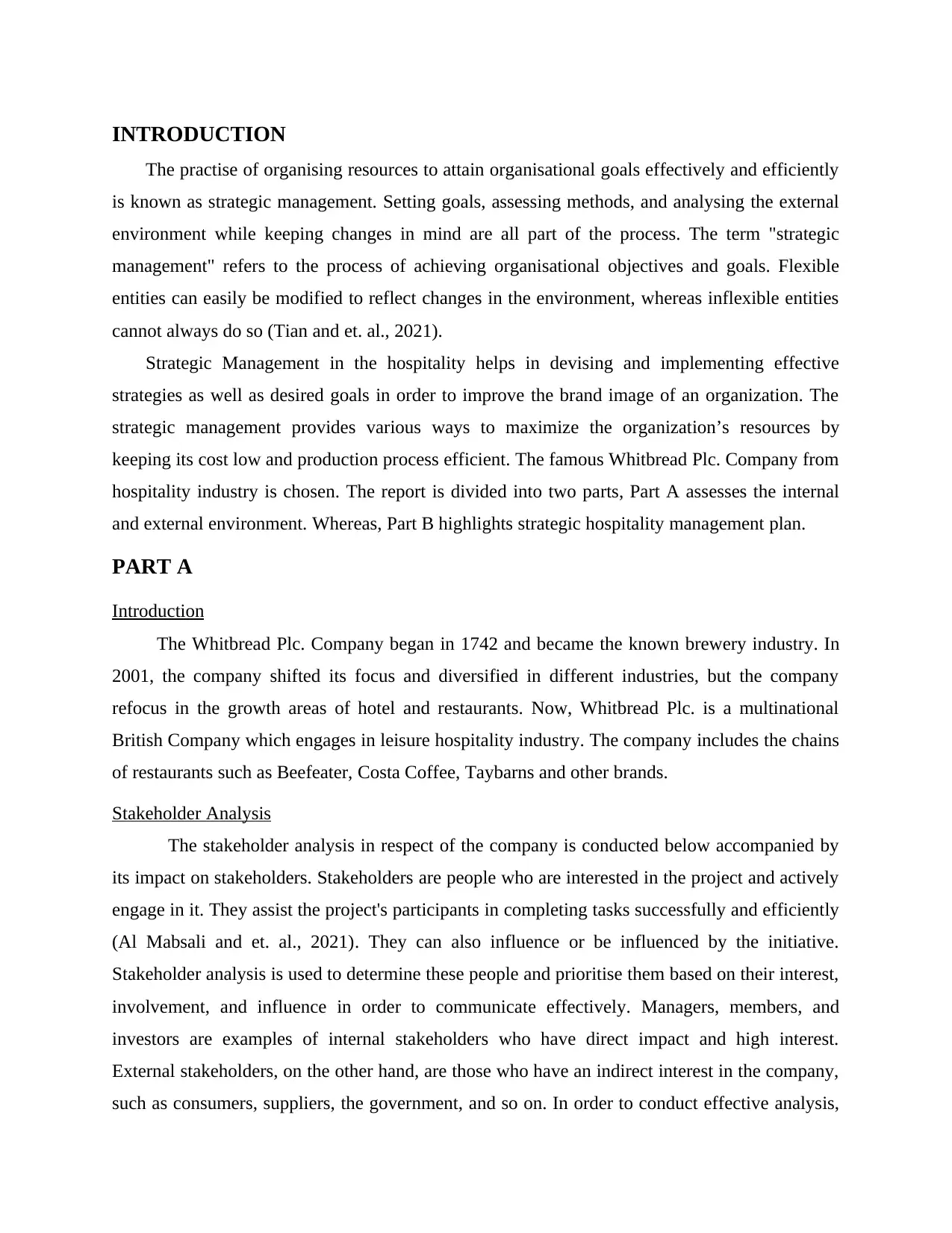
INTRODUCTION
The practise of organising resources to attain organisational goals effectively and efficiently
is known as strategic management. Setting goals, assessing methods, and analysing the external
environment while keeping changes in mind are all part of the process. The term "strategic
management" refers to the process of achieving organisational objectives and goals. Flexible
entities can easily be modified to reflect changes in the environment, whereas inflexible entities
cannot always do so (Tian and et. al., 2021).
Strategic Management in the hospitality helps in devising and implementing effective
strategies as well as desired goals in order to improve the brand image of an organization. The
strategic management provides various ways to maximize the organization’s resources by
keeping its cost low and production process efficient. The famous Whitbread Plc. Company from
hospitality industry is chosen. The report is divided into two parts, Part A assesses the internal
and external environment. Whereas, Part B highlights strategic hospitality management plan.
PART A
Introduction
The Whitbread Plc. Company began in 1742 and became the known brewery industry. In
2001, the company shifted its focus and diversified in different industries, but the company
refocus in the growth areas of hotel and restaurants. Now, Whitbread Plc. is a multinational
British Company which engages in leisure hospitality industry. The company includes the chains
of restaurants such as Beefeater, Costa Coffee, Taybarns and other brands.
Stakeholder Analysis
The stakeholder analysis in respect of the company is conducted below accompanied by
its impact on stakeholders. Stakeholders are people who are interested in the project and actively
engage in it. They assist the project's participants in completing tasks successfully and efficiently
(Al Mabsali and et. al., 2021). They can also influence or be influenced by the initiative.
Stakeholder analysis is used to determine these people and prioritise them based on their interest,
involvement, and influence in order to communicate effectively. Managers, members, and
investors are examples of internal stakeholders who have direct impact and high interest.
External stakeholders, on the other hand, are those who have an indirect interest in the company,
such as consumers, suppliers, the government, and so on. In order to conduct effective analysis,
The practise of organising resources to attain organisational goals effectively and efficiently
is known as strategic management. Setting goals, assessing methods, and analysing the external
environment while keeping changes in mind are all part of the process. The term "strategic
management" refers to the process of achieving organisational objectives and goals. Flexible
entities can easily be modified to reflect changes in the environment, whereas inflexible entities
cannot always do so (Tian and et. al., 2021).
Strategic Management in the hospitality helps in devising and implementing effective
strategies as well as desired goals in order to improve the brand image of an organization. The
strategic management provides various ways to maximize the organization’s resources by
keeping its cost low and production process efficient. The famous Whitbread Plc. Company from
hospitality industry is chosen. The report is divided into two parts, Part A assesses the internal
and external environment. Whereas, Part B highlights strategic hospitality management plan.
PART A
Introduction
The Whitbread Plc. Company began in 1742 and became the known brewery industry. In
2001, the company shifted its focus and diversified in different industries, but the company
refocus in the growth areas of hotel and restaurants. Now, Whitbread Plc. is a multinational
British Company which engages in leisure hospitality industry. The company includes the chains
of restaurants such as Beefeater, Costa Coffee, Taybarns and other brands.
Stakeholder Analysis
The stakeholder analysis in respect of the company is conducted below accompanied by
its impact on stakeholders. Stakeholders are people who are interested in the project and actively
engage in it. They assist the project's participants in completing tasks successfully and efficiently
(Al Mabsali and et. al., 2021). They can also influence or be influenced by the initiative.
Stakeholder analysis is used to determine these people and prioritise them based on their interest,
involvement, and influence in order to communicate effectively. Managers, members, and
investors are examples of internal stakeholders who have direct impact and high interest.
External stakeholders, on the other hand, are those who have an indirect interest in the company,
such as consumers, suppliers, the government, and so on. In order to conduct effective analysis,
⊘ This is a preview!⊘
Do you want full access?
Subscribe today to unlock all pages.

Trusted by 1+ million students worldwide
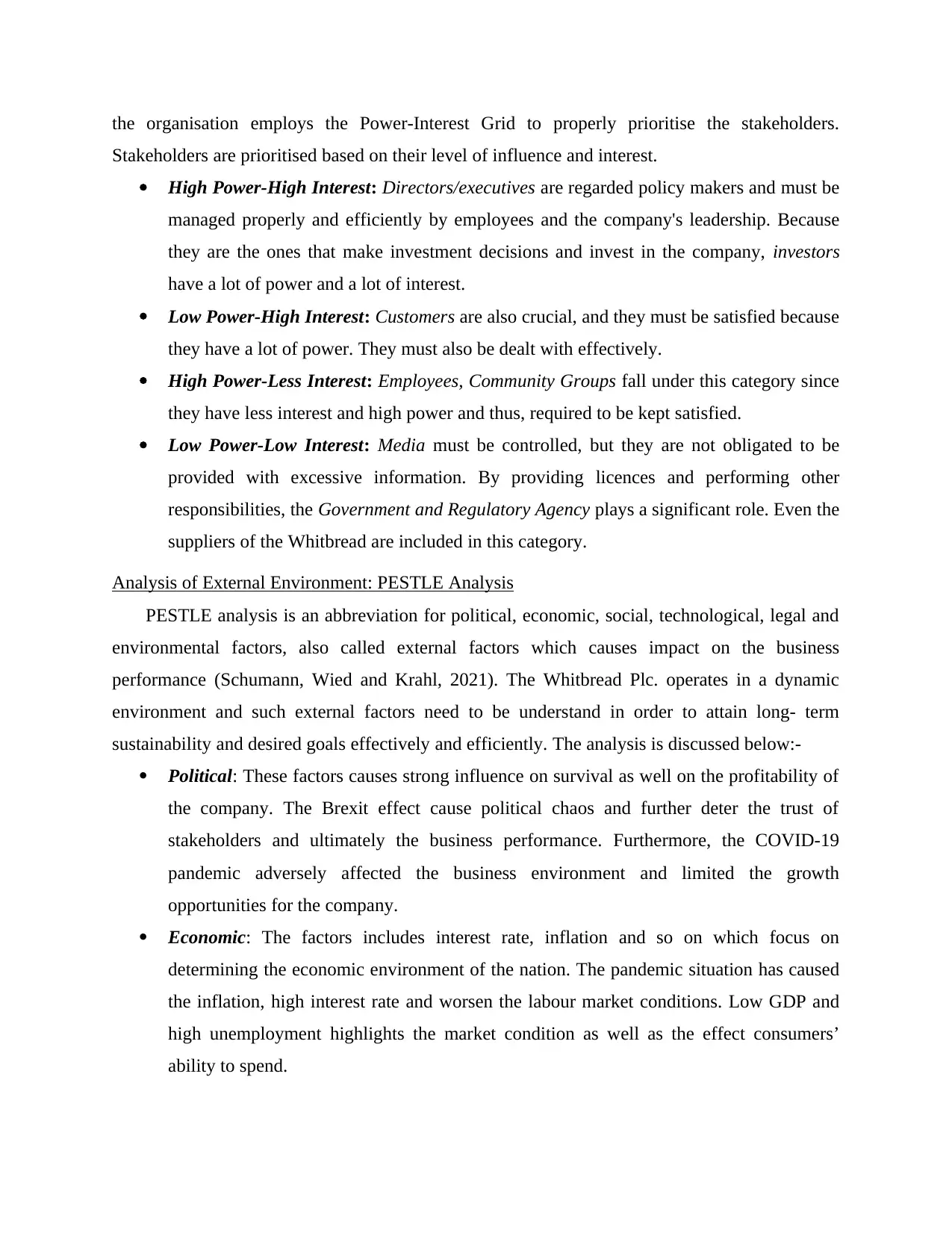
the organisation employs the Power-Interest Grid to properly prioritise the stakeholders.
Stakeholders are prioritised based on their level of influence and interest.
High Power-High Interest: Directors/executives are regarded policy makers and must be
managed properly and efficiently by employees and the company's leadership. Because
they are the ones that make investment decisions and invest in the company, investors
have a lot of power and a lot of interest.
Low Power-High Interest: Customers are also crucial, and they must be satisfied because
they have a lot of power. They must also be dealt with effectively.
High Power-Less Interest: Employees, Community Groups fall under this category since
they have less interest and high power and thus, required to be kept satisfied.
Low Power-Low Interest: Media must be controlled, but they are not obligated to be
provided with excessive information. By providing licences and performing other
responsibilities, the Government and Regulatory Agency plays a significant role. Even the
suppliers of the Whitbread are included in this category.
Analysis of External Environment: PESTLE Analysis
PESTLE analysis is an abbreviation for political, economic, social, technological, legal and
environmental factors, also called external factors which causes impact on the business
performance (Schumann, Wied and Krahl, 2021). The Whitbread Plc. operates in a dynamic
environment and such external factors need to be understand in order to attain long- term
sustainability and desired goals effectively and efficiently. The analysis is discussed below:-
Political: These factors causes strong influence on survival as well on the profitability of
the company. The Brexit effect cause political chaos and further deter the trust of
stakeholders and ultimately the business performance. Furthermore, the COVID-19
pandemic adversely affected the business environment and limited the growth
opportunities for the company.
Economic: The factors includes interest rate, inflation and so on which focus on
determining the economic environment of the nation. The pandemic situation has caused
the inflation, high interest rate and worsen the labour market conditions. Low GDP and
high unemployment highlights the market condition as well as the effect consumers’
ability to spend.
Stakeholders are prioritised based on their level of influence and interest.
High Power-High Interest: Directors/executives are regarded policy makers and must be
managed properly and efficiently by employees and the company's leadership. Because
they are the ones that make investment decisions and invest in the company, investors
have a lot of power and a lot of interest.
Low Power-High Interest: Customers are also crucial, and they must be satisfied because
they have a lot of power. They must also be dealt with effectively.
High Power-Less Interest: Employees, Community Groups fall under this category since
they have less interest and high power and thus, required to be kept satisfied.
Low Power-Low Interest: Media must be controlled, but they are not obligated to be
provided with excessive information. By providing licences and performing other
responsibilities, the Government and Regulatory Agency plays a significant role. Even the
suppliers of the Whitbread are included in this category.
Analysis of External Environment: PESTLE Analysis
PESTLE analysis is an abbreviation for political, economic, social, technological, legal and
environmental factors, also called external factors which causes impact on the business
performance (Schumann, Wied and Krahl, 2021). The Whitbread Plc. operates in a dynamic
environment and such external factors need to be understand in order to attain long- term
sustainability and desired goals effectively and efficiently. The analysis is discussed below:-
Political: These factors causes strong influence on survival as well on the profitability of
the company. The Brexit effect cause political chaos and further deter the trust of
stakeholders and ultimately the business performance. Furthermore, the COVID-19
pandemic adversely affected the business environment and limited the growth
opportunities for the company.
Economic: The factors includes interest rate, inflation and so on which focus on
determining the economic environment of the nation. The pandemic situation has caused
the inflation, high interest rate and worsen the labour market conditions. Low GDP and
high unemployment highlights the market condition as well as the effect consumers’
ability to spend.
Paraphrase This Document
Need a fresh take? Get an instant paraphrase of this document with our AI Paraphraser
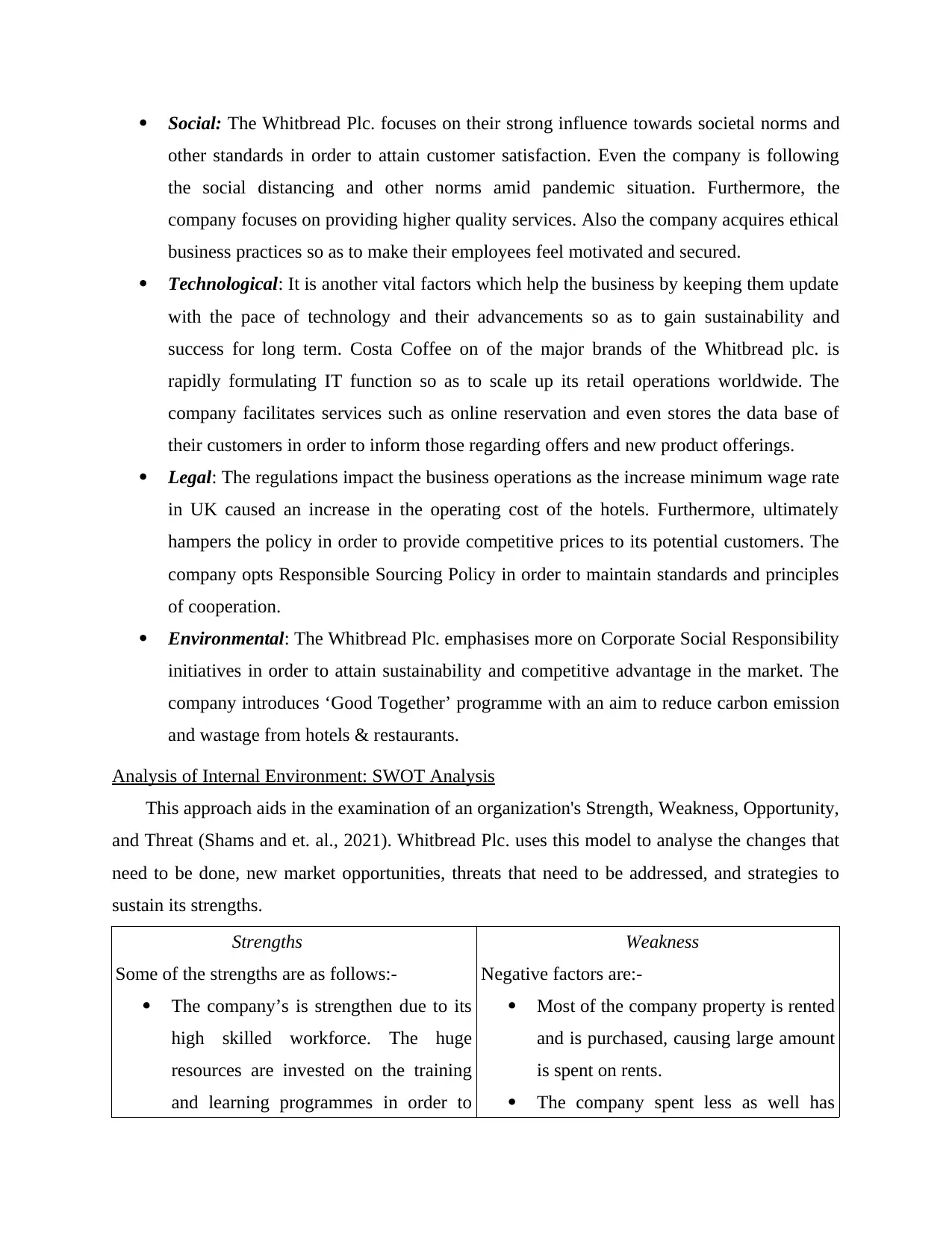
Social: The Whitbread Plc. focuses on their strong influence towards societal norms and
other standards in order to attain customer satisfaction. Even the company is following
the social distancing and other norms amid pandemic situation. Furthermore, the
company focuses on providing higher quality services. Also the company acquires ethical
business practices so as to make their employees feel motivated and secured.
Technological: It is another vital factors which help the business by keeping them update
with the pace of technology and their advancements so as to gain sustainability and
success for long term. Costa Coffee on of the major brands of the Whitbread plc. is
rapidly formulating IT function so as to scale up its retail operations worldwide. The
company facilitates services such as online reservation and even stores the data base of
their customers in order to inform those regarding offers and new product offerings.
Legal: The regulations impact the business operations as the increase minimum wage rate
in UK caused an increase in the operating cost of the hotels. Furthermore, ultimately
hampers the policy in order to provide competitive prices to its potential customers. The
company opts Responsible Sourcing Policy in order to maintain standards and principles
of cooperation.
Environmental: The Whitbread Plc. emphasises more on Corporate Social Responsibility
initiatives in order to attain sustainability and competitive advantage in the market. The
company introduces ‘Good Together’ programme with an aim to reduce carbon emission
and wastage from hotels & restaurants.
Analysis of Internal Environment: SWOT Analysis
This approach aids in the examination of an organization's Strength, Weakness, Opportunity,
and Threat (Shams and et. al., 2021). Whitbread Plc. uses this model to analyse the changes that
need to be done, new market opportunities, threats that need to be addressed, and strategies to
sustain its strengths.
Strengths
Some of the strengths are as follows:-
The company’s is strengthen due to its
high skilled workforce. The huge
resources are invested on the training
and learning programmes in order to
Weakness
Negative factors are:-
Most of the company property is rented
and is purchased, causing large amount
is spent on rents.
The company spent less as well has
other standards in order to attain customer satisfaction. Even the company is following
the social distancing and other norms amid pandemic situation. Furthermore, the
company focuses on providing higher quality services. Also the company acquires ethical
business practices so as to make their employees feel motivated and secured.
Technological: It is another vital factors which help the business by keeping them update
with the pace of technology and their advancements so as to gain sustainability and
success for long term. Costa Coffee on of the major brands of the Whitbread plc. is
rapidly formulating IT function so as to scale up its retail operations worldwide. The
company facilitates services such as online reservation and even stores the data base of
their customers in order to inform those regarding offers and new product offerings.
Legal: The regulations impact the business operations as the increase minimum wage rate
in UK caused an increase in the operating cost of the hotels. Furthermore, ultimately
hampers the policy in order to provide competitive prices to its potential customers. The
company opts Responsible Sourcing Policy in order to maintain standards and principles
of cooperation.
Environmental: The Whitbread Plc. emphasises more on Corporate Social Responsibility
initiatives in order to attain sustainability and competitive advantage in the market. The
company introduces ‘Good Together’ programme with an aim to reduce carbon emission
and wastage from hotels & restaurants.
Analysis of Internal Environment: SWOT Analysis
This approach aids in the examination of an organization's Strength, Weakness, Opportunity,
and Threat (Shams and et. al., 2021). Whitbread Plc. uses this model to analyse the changes that
need to be done, new market opportunities, threats that need to be addressed, and strategies to
sustain its strengths.
Strengths
Some of the strengths are as follows:-
The company’s is strengthen due to its
high skilled workforce. The huge
resources are invested on the training
and learning programmes in order to
Weakness
Negative factors are:-
Most of the company property is rented
and is purchased, causing large amount
is spent on rents.
The company spent less as well has
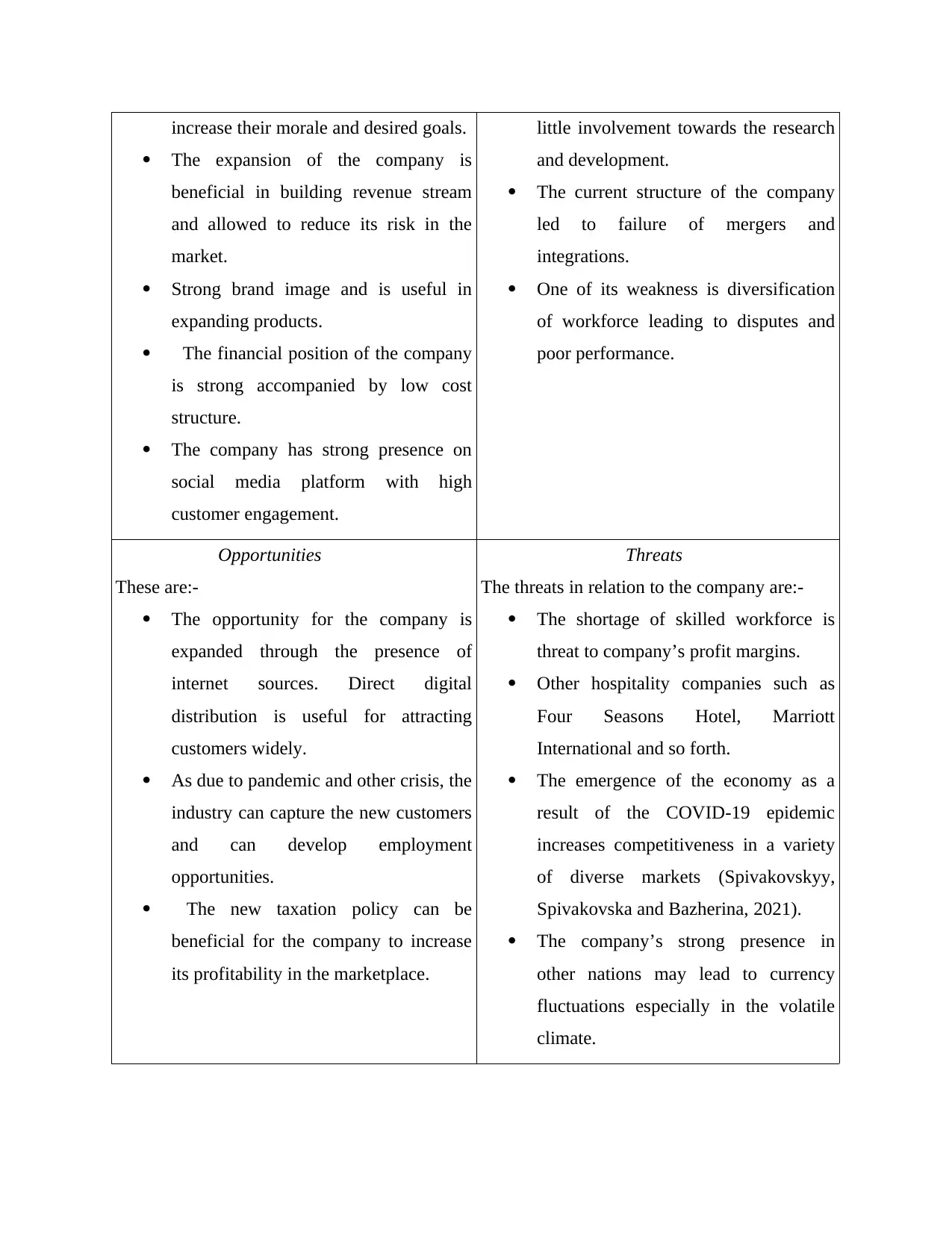
increase their morale and desired goals.
The expansion of the company is
beneficial in building revenue stream
and allowed to reduce its risk in the
market.
Strong brand image and is useful in
expanding products.
The financial position of the company
is strong accompanied by low cost
structure.
The company has strong presence on
social media platform with high
customer engagement.
little involvement towards the research
and development.
The current structure of the company
led to failure of mergers and
integrations.
One of its weakness is diversification
of workforce leading to disputes and
poor performance.
Opportunities
These are:-
The opportunity for the company is
expanded through the presence of
internet sources. Direct digital
distribution is useful for attracting
customers widely.
As due to pandemic and other crisis, the
industry can capture the new customers
and can develop employment
opportunities.
The new taxation policy can be
beneficial for the company to increase
its profitability in the marketplace.
Threats
The threats in relation to the company are:-
The shortage of skilled workforce is
threat to company’s profit margins.
Other hospitality companies such as
Four Seasons Hotel, Marriott
International and so forth.
The emergence of the economy as a
result of the COVID-19 epidemic
increases competitiveness in a variety
of diverse markets (Spivakovskyy,
Spivakovska and Bazherina, 2021).
The company’s strong presence in
other nations may lead to currency
fluctuations especially in the volatile
climate.
The expansion of the company is
beneficial in building revenue stream
and allowed to reduce its risk in the
market.
Strong brand image and is useful in
expanding products.
The financial position of the company
is strong accompanied by low cost
structure.
The company has strong presence on
social media platform with high
customer engagement.
little involvement towards the research
and development.
The current structure of the company
led to failure of mergers and
integrations.
One of its weakness is diversification
of workforce leading to disputes and
poor performance.
Opportunities
These are:-
The opportunity for the company is
expanded through the presence of
internet sources. Direct digital
distribution is useful for attracting
customers widely.
As due to pandemic and other crisis, the
industry can capture the new customers
and can develop employment
opportunities.
The new taxation policy can be
beneficial for the company to increase
its profitability in the marketplace.
Threats
The threats in relation to the company are:-
The shortage of skilled workforce is
threat to company’s profit margins.
Other hospitality companies such as
Four Seasons Hotel, Marriott
International and so forth.
The emergence of the economy as a
result of the COVID-19 epidemic
increases competitiveness in a variety
of diverse markets (Spivakovskyy,
Spivakovska and Bazherina, 2021).
The company’s strong presence in
other nations may lead to currency
fluctuations especially in the volatile
climate.
⊘ This is a preview!⊘
Do you want full access?
Subscribe today to unlock all pages.

Trusted by 1+ million students worldwide
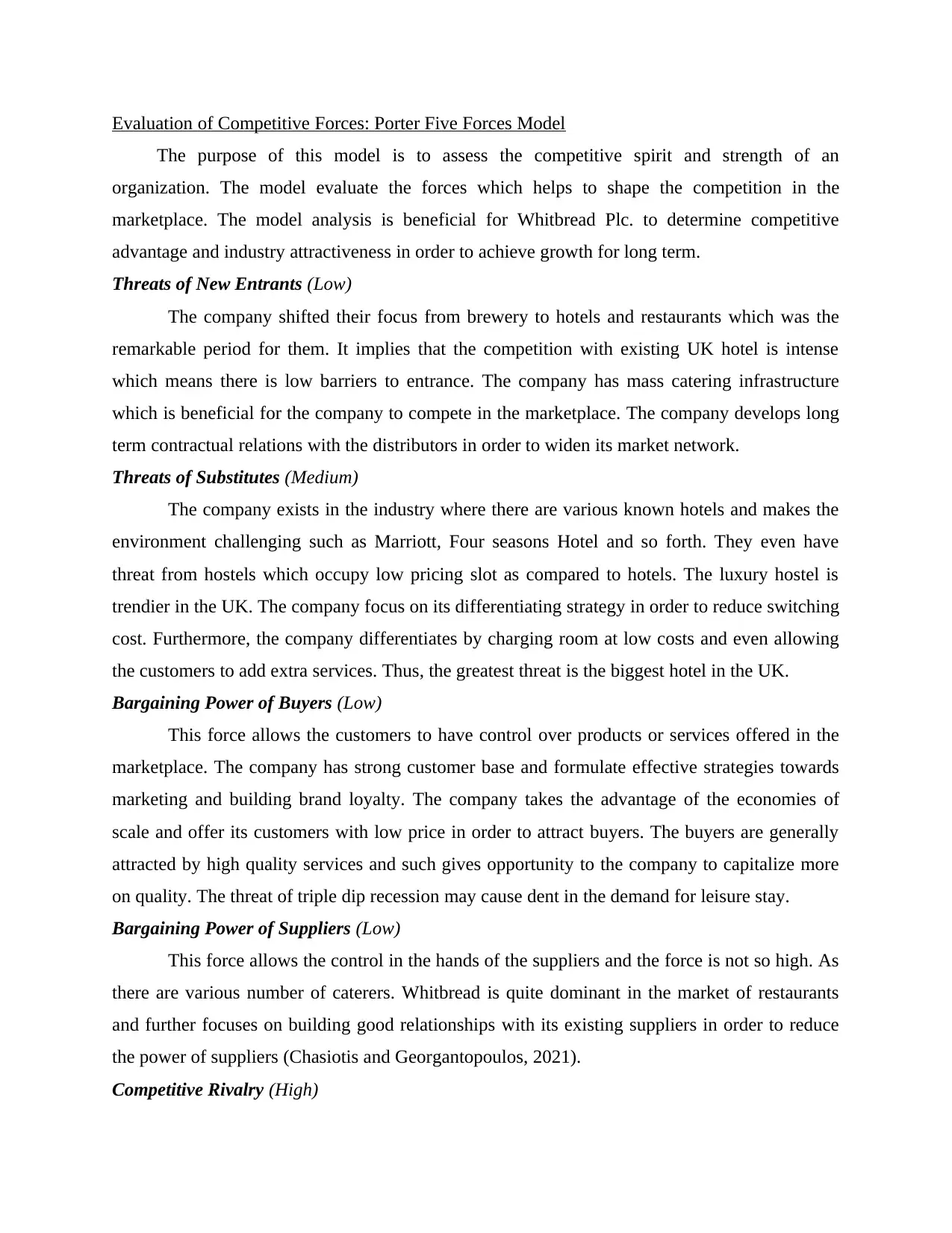
Evaluation of Competitive Forces: Porter Five Forces Model
The purpose of this model is to assess the competitive spirit and strength of an
organization. The model evaluate the forces which helps to shape the competition in the
marketplace. The model analysis is beneficial for Whitbread Plc. to determine competitive
advantage and industry attractiveness in order to achieve growth for long term.
Threats of New Entrants (Low)
The company shifted their focus from brewery to hotels and restaurants which was the
remarkable period for them. It implies that the competition with existing UK hotel is intense
which means there is low barriers to entrance. The company has mass catering infrastructure
which is beneficial for the company to compete in the marketplace. The company develops long
term contractual relations with the distributors in order to widen its market network.
Threats of Substitutes (Medium)
The company exists in the industry where there are various known hotels and makes the
environment challenging such as Marriott, Four seasons Hotel and so forth. They even have
threat from hostels which occupy low pricing slot as compared to hotels. The luxury hostel is
trendier in the UK. The company focus on its differentiating strategy in order to reduce switching
cost. Furthermore, the company differentiates by charging room at low costs and even allowing
the customers to add extra services. Thus, the greatest threat is the biggest hotel in the UK.
Bargaining Power of Buyers (Low)
This force allows the customers to have control over products or services offered in the
marketplace. The company has strong customer base and formulate effective strategies towards
marketing and building brand loyalty. The company takes the advantage of the economies of
scale and offer its customers with low price in order to attract buyers. The buyers are generally
attracted by high quality services and such gives opportunity to the company to capitalize more
on quality. The threat of triple dip recession may cause dent in the demand for leisure stay.
Bargaining Power of Suppliers (Low)
This force allows the control in the hands of the suppliers and the force is not so high. As
there are various number of caterers. Whitbread is quite dominant in the market of restaurants
and further focuses on building good relationships with its existing suppliers in order to reduce
the power of suppliers (Chasiotis and Georgantopoulos, 2021).
Competitive Rivalry (High)
The purpose of this model is to assess the competitive spirit and strength of an
organization. The model evaluate the forces which helps to shape the competition in the
marketplace. The model analysis is beneficial for Whitbread Plc. to determine competitive
advantage and industry attractiveness in order to achieve growth for long term.
Threats of New Entrants (Low)
The company shifted their focus from brewery to hotels and restaurants which was the
remarkable period for them. It implies that the competition with existing UK hotel is intense
which means there is low barriers to entrance. The company has mass catering infrastructure
which is beneficial for the company to compete in the marketplace. The company develops long
term contractual relations with the distributors in order to widen its market network.
Threats of Substitutes (Medium)
The company exists in the industry where there are various known hotels and makes the
environment challenging such as Marriott, Four seasons Hotel and so forth. They even have
threat from hostels which occupy low pricing slot as compared to hotels. The luxury hostel is
trendier in the UK. The company focus on its differentiating strategy in order to reduce switching
cost. Furthermore, the company differentiates by charging room at low costs and even allowing
the customers to add extra services. Thus, the greatest threat is the biggest hotel in the UK.
Bargaining Power of Buyers (Low)
This force allows the customers to have control over products or services offered in the
marketplace. The company has strong customer base and formulate effective strategies towards
marketing and building brand loyalty. The company takes the advantage of the economies of
scale and offer its customers with low price in order to attract buyers. The buyers are generally
attracted by high quality services and such gives opportunity to the company to capitalize more
on quality. The threat of triple dip recession may cause dent in the demand for leisure stay.
Bargaining Power of Suppliers (Low)
This force allows the control in the hands of the suppliers and the force is not so high. As
there are various number of caterers. Whitbread is quite dominant in the market of restaurants
and further focuses on building good relationships with its existing suppliers in order to reduce
the power of suppliers (Chasiotis and Georgantopoulos, 2021).
Competitive Rivalry (High)
Paraphrase This Document
Need a fresh take? Get an instant paraphrase of this document with our AI Paraphraser
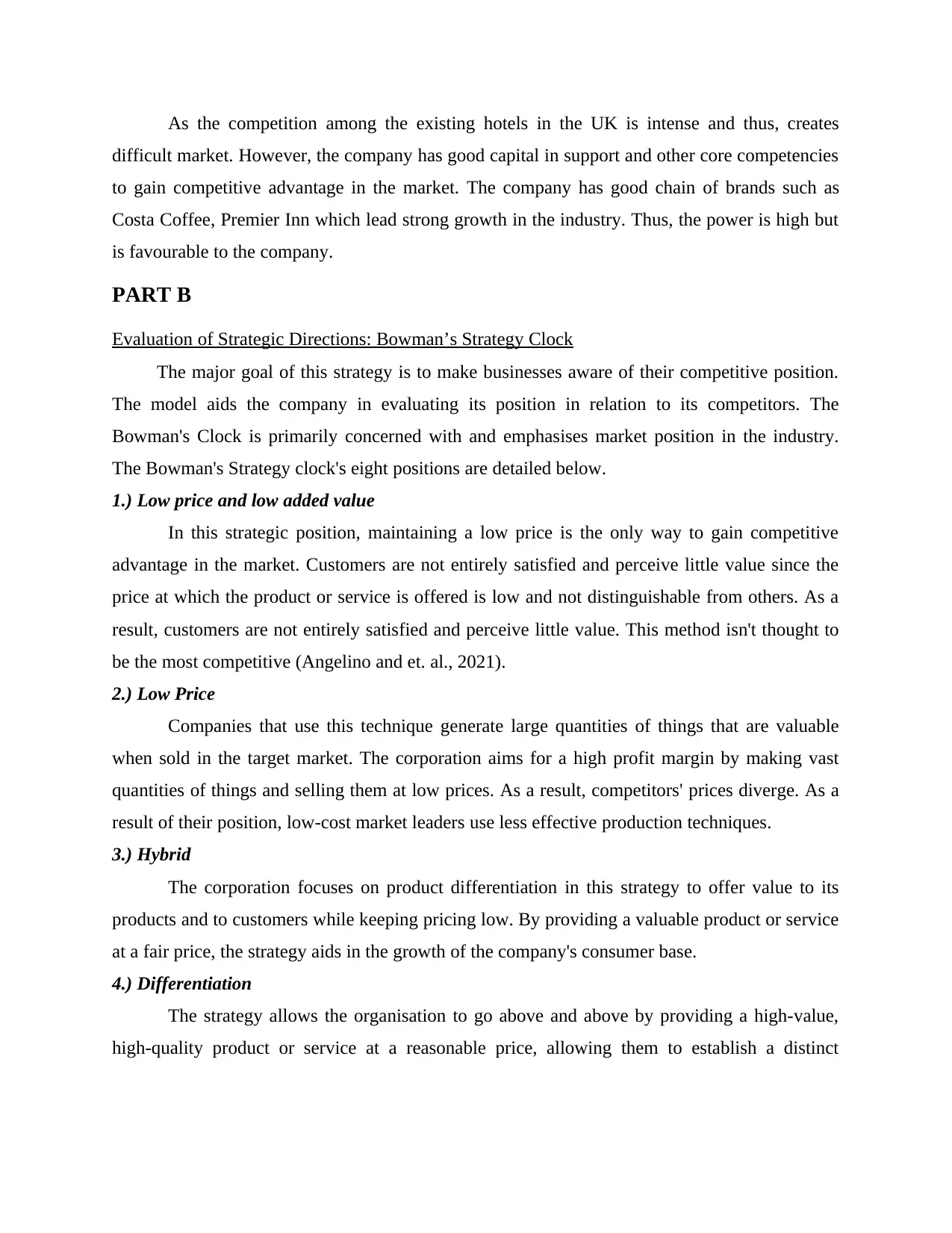
As the competition among the existing hotels in the UK is intense and thus, creates
difficult market. However, the company has good capital in support and other core competencies
to gain competitive advantage in the market. The company has good chain of brands such as
Costa Coffee, Premier Inn which lead strong growth in the industry. Thus, the power is high but
is favourable to the company.
PART B
Evaluation of Strategic Directions: Bowman’s Strategy Clock
The major goal of this strategy is to make businesses aware of their competitive position.
The model aids the company in evaluating its position in relation to its competitors. The
Bowman's Clock is primarily concerned with and emphasises market position in the industry.
The Bowman's Strategy clock's eight positions are detailed below.
1.) Low price and low added value
In this strategic position, maintaining a low price is the only way to gain competitive
advantage in the market. Customers are not entirely satisfied and perceive little value since the
price at which the product or service is offered is low and not distinguishable from others. As a
result, customers are not entirely satisfied and perceive little value. This method isn't thought to
be the most competitive (Angelino and et. al., 2021).
2.) Low Price
Companies that use this technique generate large quantities of things that are valuable
when sold in the target market. The corporation aims for a high profit margin by making vast
quantities of things and selling them at low prices. As a result, competitors' prices diverge. As a
result of their position, low-cost market leaders use less effective production techniques.
3.) Hybrid
The corporation focuses on product differentiation in this strategy to offer value to its
products and to customers while keeping pricing low. By providing a valuable product or service
at a fair price, the strategy aids in the growth of the company's consumer base.
4.) Differentiation
The strategy allows the organisation to go above and above by providing a high-value,
high-quality product or service at a reasonable price, allowing them to establish a distinct
difficult market. However, the company has good capital in support and other core competencies
to gain competitive advantage in the market. The company has good chain of brands such as
Costa Coffee, Premier Inn which lead strong growth in the industry. Thus, the power is high but
is favourable to the company.
PART B
Evaluation of Strategic Directions: Bowman’s Strategy Clock
The major goal of this strategy is to make businesses aware of their competitive position.
The model aids the company in evaluating its position in relation to its competitors. The
Bowman's Clock is primarily concerned with and emphasises market position in the industry.
The Bowman's Strategy clock's eight positions are detailed below.
1.) Low price and low added value
In this strategic position, maintaining a low price is the only way to gain competitive
advantage in the market. Customers are not entirely satisfied and perceive little value since the
price at which the product or service is offered is low and not distinguishable from others. As a
result, customers are not entirely satisfied and perceive little value. This method isn't thought to
be the most competitive (Angelino and et. al., 2021).
2.) Low Price
Companies that use this technique generate large quantities of things that are valuable
when sold in the target market. The corporation aims for a high profit margin by making vast
quantities of things and selling them at low prices. As a result, competitors' prices diverge. As a
result of their position, low-cost market leaders use less effective production techniques.
3.) Hybrid
The corporation focuses on product differentiation in this strategy to offer value to its
products and to customers while keeping pricing low. By providing a valuable product or service
at a fair price, the strategy aids in the growth of the company's consumer base.
4.) Differentiation
The strategy allows the organisation to go above and above by providing a high-value,
high-quality product or service at a reasonable price, allowing them to establish a distinct
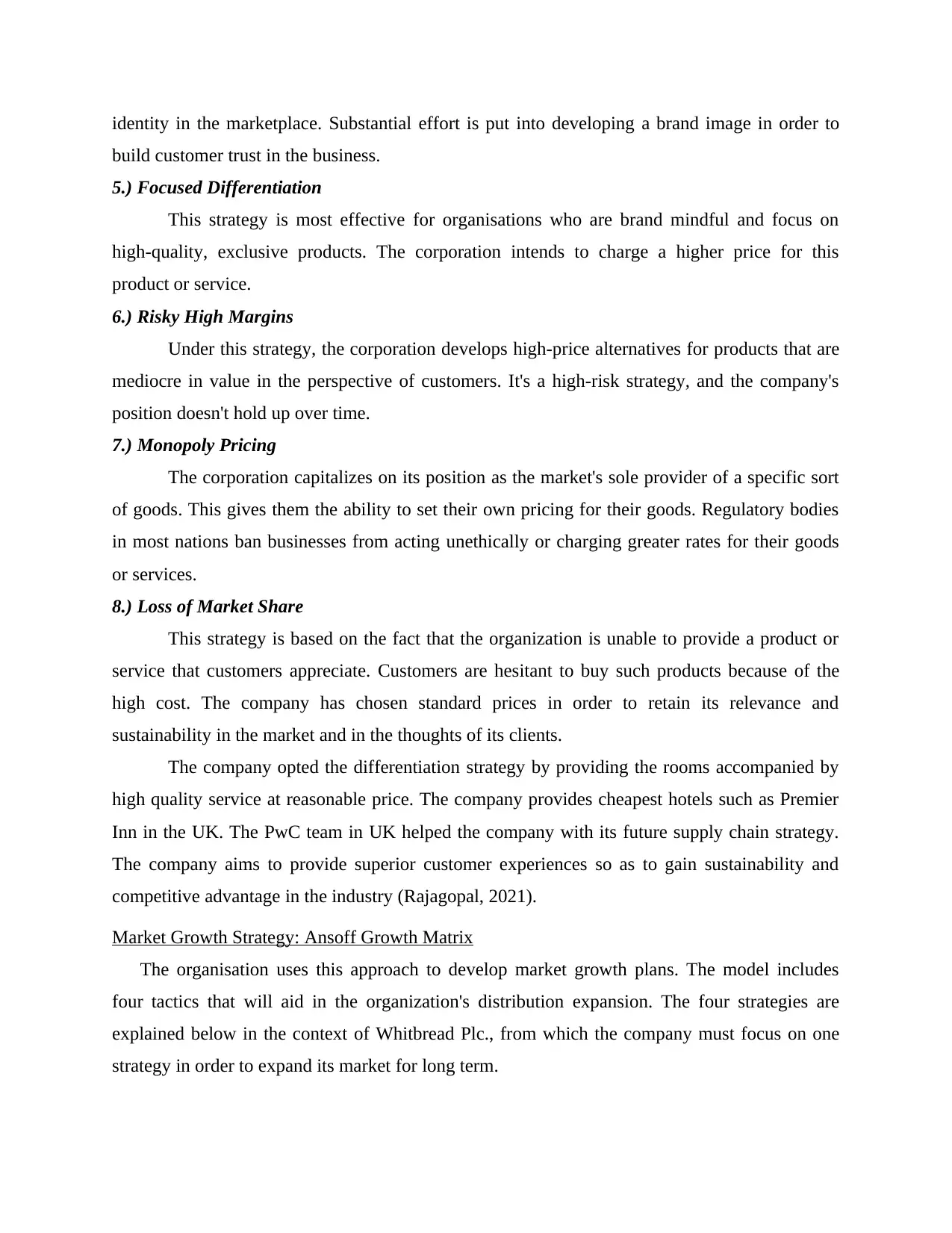
identity in the marketplace. Substantial effort is put into developing a brand image in order to
build customer trust in the business.
5.) Focused Differentiation
This strategy is most effective for organisations who are brand mindful and focus on
high-quality, exclusive products. The corporation intends to charge a higher price for this
product or service.
6.) Risky High Margins
Under this strategy, the corporation develops high-price alternatives for products that are
mediocre in value in the perspective of customers. It's a high-risk strategy, and the company's
position doesn't hold up over time.
7.) Monopoly Pricing
The corporation capitalizes on its position as the market's sole provider of a specific sort
of goods. This gives them the ability to set their own pricing for their goods. Regulatory bodies
in most nations ban businesses from acting unethically or charging greater rates for their goods
or services.
8.) Loss of Market Share
This strategy is based on the fact that the organization is unable to provide a product or
service that customers appreciate. Customers are hesitant to buy such products because of the
high cost. The company has chosen standard prices in order to retain its relevance and
sustainability in the market and in the thoughts of its clients.
The company opted the differentiation strategy by providing the rooms accompanied by
high quality service at reasonable price. The company provides cheapest hotels such as Premier
Inn in the UK. The PwC team in UK helped the company with its future supply chain strategy.
The company aims to provide superior customer experiences so as to gain sustainability and
competitive advantage in the industry (Rajagopal, 2021).
Market Growth Strategy: Ansoff Growth Matrix
The organisation uses this approach to develop market growth plans. The model includes
four tactics that will aid in the organization's distribution expansion. The four strategies are
explained below in the context of Whitbread Plc., from which the company must focus on one
strategy in order to expand its market for long term.
build customer trust in the business.
5.) Focused Differentiation
This strategy is most effective for organisations who are brand mindful and focus on
high-quality, exclusive products. The corporation intends to charge a higher price for this
product or service.
6.) Risky High Margins
Under this strategy, the corporation develops high-price alternatives for products that are
mediocre in value in the perspective of customers. It's a high-risk strategy, and the company's
position doesn't hold up over time.
7.) Monopoly Pricing
The corporation capitalizes on its position as the market's sole provider of a specific sort
of goods. This gives them the ability to set their own pricing for their goods. Regulatory bodies
in most nations ban businesses from acting unethically or charging greater rates for their goods
or services.
8.) Loss of Market Share
This strategy is based on the fact that the organization is unable to provide a product or
service that customers appreciate. Customers are hesitant to buy such products because of the
high cost. The company has chosen standard prices in order to retain its relevance and
sustainability in the market and in the thoughts of its clients.
The company opted the differentiation strategy by providing the rooms accompanied by
high quality service at reasonable price. The company provides cheapest hotels such as Premier
Inn in the UK. The PwC team in UK helped the company with its future supply chain strategy.
The company aims to provide superior customer experiences so as to gain sustainability and
competitive advantage in the industry (Rajagopal, 2021).
Market Growth Strategy: Ansoff Growth Matrix
The organisation uses this approach to develop market growth plans. The model includes
four tactics that will aid in the organization's distribution expansion. The four strategies are
explained below in the context of Whitbread Plc., from which the company must focus on one
strategy in order to expand its market for long term.
⊘ This is a preview!⊘
Do you want full access?
Subscribe today to unlock all pages.

Trusted by 1+ million students worldwide
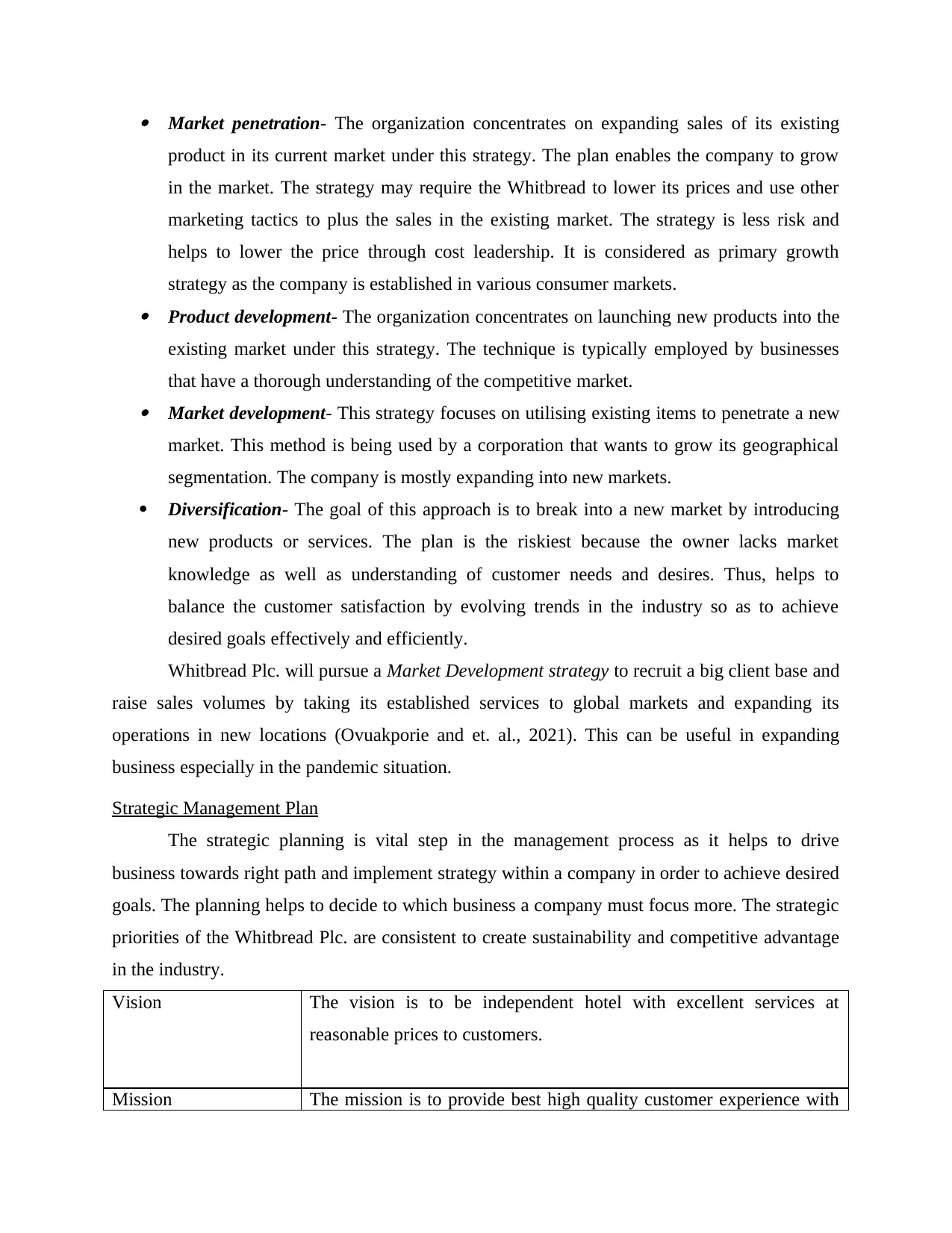
Market penetration- The organization concentrates on expanding sales of its existing
product in its current market under this strategy. The plan enables the company to grow
in the market. The strategy may require the Whitbread to lower its prices and use other
marketing tactics to plus the sales in the existing market. The strategy is less risk and
helps to lower the price through cost leadership. It is considered as primary growth
strategy as the company is established in various consumer markets. Product development- The organization concentrates on launching new products into the
existing market under this strategy. The technique is typically employed by businesses
that have a thorough understanding of the competitive market. Market development- This strategy focuses on utilising existing items to penetrate a new
market. This method is being used by a corporation that wants to grow its geographical
segmentation. The company is mostly expanding into new markets.
Diversification- The goal of this approach is to break into a new market by introducing
new products or services. The plan is the riskiest because the owner lacks market
knowledge as well as understanding of customer needs and desires. Thus, helps to
balance the customer satisfaction by evolving trends in the industry so as to achieve
desired goals effectively and efficiently.
Whitbread Plc. will pursue a Market Development strategy to recruit a big client base and
raise sales volumes by taking its established services to global markets and expanding its
operations in new locations (Ovuakporie and et. al., 2021). This can be useful in expanding
business especially in the pandemic situation.
Strategic Management Plan
The strategic planning is vital step in the management process as it helps to drive
business towards right path and implement strategy within a company in order to achieve desired
goals. The planning helps to decide to which business a company must focus more. The strategic
priorities of the Whitbread Plc. are consistent to create sustainability and competitive advantage
in the industry.
Vision The vision is to be independent hotel with excellent services at
reasonable prices to customers.
Mission The mission is to provide best high quality customer experience with
product in its current market under this strategy. The plan enables the company to grow
in the market. The strategy may require the Whitbread to lower its prices and use other
marketing tactics to plus the sales in the existing market. The strategy is less risk and
helps to lower the price through cost leadership. It is considered as primary growth
strategy as the company is established in various consumer markets. Product development- The organization concentrates on launching new products into the
existing market under this strategy. The technique is typically employed by businesses
that have a thorough understanding of the competitive market. Market development- This strategy focuses on utilising existing items to penetrate a new
market. This method is being used by a corporation that wants to grow its geographical
segmentation. The company is mostly expanding into new markets.
Diversification- The goal of this approach is to break into a new market by introducing
new products or services. The plan is the riskiest because the owner lacks market
knowledge as well as understanding of customer needs and desires. Thus, helps to
balance the customer satisfaction by evolving trends in the industry so as to achieve
desired goals effectively and efficiently.
Whitbread Plc. will pursue a Market Development strategy to recruit a big client base and
raise sales volumes by taking its established services to global markets and expanding its
operations in new locations (Ovuakporie and et. al., 2021). This can be useful in expanding
business especially in the pandemic situation.
Strategic Management Plan
The strategic planning is vital step in the management process as it helps to drive
business towards right path and implement strategy within a company in order to achieve desired
goals. The planning helps to decide to which business a company must focus more. The strategic
priorities of the Whitbread Plc. are consistent to create sustainability and competitive advantage
in the industry.
Vision The vision is to be independent hotel with excellent services at
reasonable prices to customers.
Mission The mission is to provide best high quality customer experience with
Paraphrase This Document
Need a fresh take? Get an instant paraphrase of this document with our AI Paraphraser
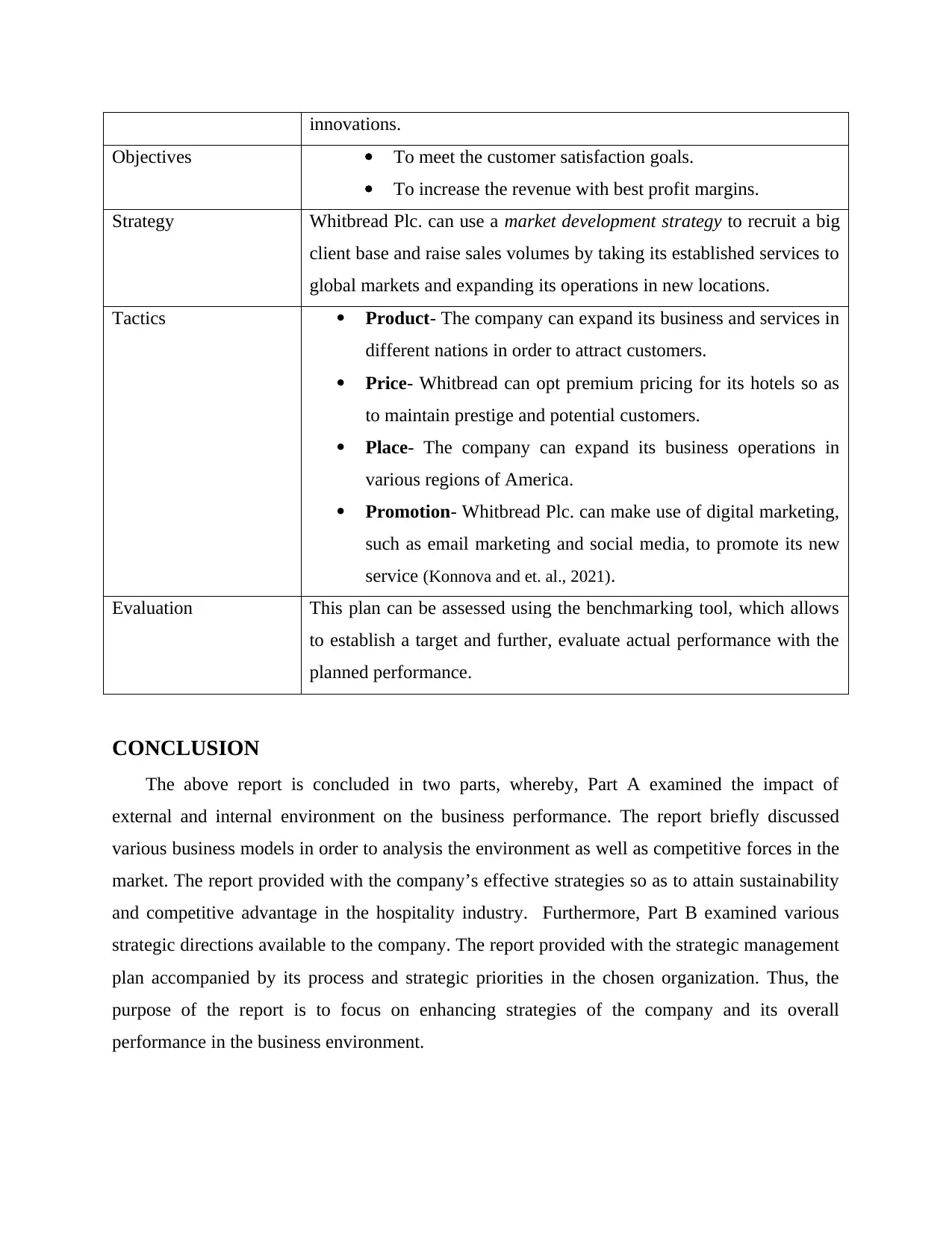
innovations.
Objectives To meet the customer satisfaction goals.
To increase the revenue with best profit margins.
Strategy Whitbread Plc. can use a market development strategy to recruit a big
client base and raise sales volumes by taking its established services to
global markets and expanding its operations in new locations.
Tactics Product- The company can expand its business and services in
different nations in order to attract customers.
Price- Whitbread can opt premium pricing for its hotels so as
to maintain prestige and potential customers.
Place- The company can expand its business operations in
various regions of America.
Promotion- Whitbread Plc. can make use of digital marketing,
such as email marketing and social media, to promote its new
service (Konnova and et. al., 2021).
Evaluation This plan can be assessed using the benchmarking tool, which allows
to establish a target and further, evaluate actual performance with the
planned performance.
CONCLUSION
The above report is concluded in two parts, whereby, Part A examined the impact of
external and internal environment on the business performance. The report briefly discussed
various business models in order to analysis the environment as well as competitive forces in the
market. The report provided with the company’s effective strategies so as to attain sustainability
and competitive advantage in the hospitality industry. Furthermore, Part B examined various
strategic directions available to the company. The report provided with the strategic management
plan accompanied by its process and strategic priorities in the chosen organization. Thus, the
purpose of the report is to focus on enhancing strategies of the company and its overall
performance in the business environment.
Objectives To meet the customer satisfaction goals.
To increase the revenue with best profit margins.
Strategy Whitbread Plc. can use a market development strategy to recruit a big
client base and raise sales volumes by taking its established services to
global markets and expanding its operations in new locations.
Tactics Product- The company can expand its business and services in
different nations in order to attract customers.
Price- Whitbread can opt premium pricing for its hotels so as
to maintain prestige and potential customers.
Place- The company can expand its business operations in
various regions of America.
Promotion- Whitbread Plc. can make use of digital marketing,
such as email marketing and social media, to promote its new
service (Konnova and et. al., 2021).
Evaluation This plan can be assessed using the benchmarking tool, which allows
to establish a target and further, evaluate actual performance with the
planned performance.
CONCLUSION
The above report is concluded in two parts, whereby, Part A examined the impact of
external and internal environment on the business performance. The report briefly discussed
various business models in order to analysis the environment as well as competitive forces in the
market. The report provided with the company’s effective strategies so as to attain sustainability
and competitive advantage in the hospitality industry. Furthermore, Part B examined various
strategic directions available to the company. The report provided with the strategic management
plan accompanied by its process and strategic priorities in the chosen organization. Thus, the
purpose of the report is to focus on enhancing strategies of the company and its overall
performance in the business environment.
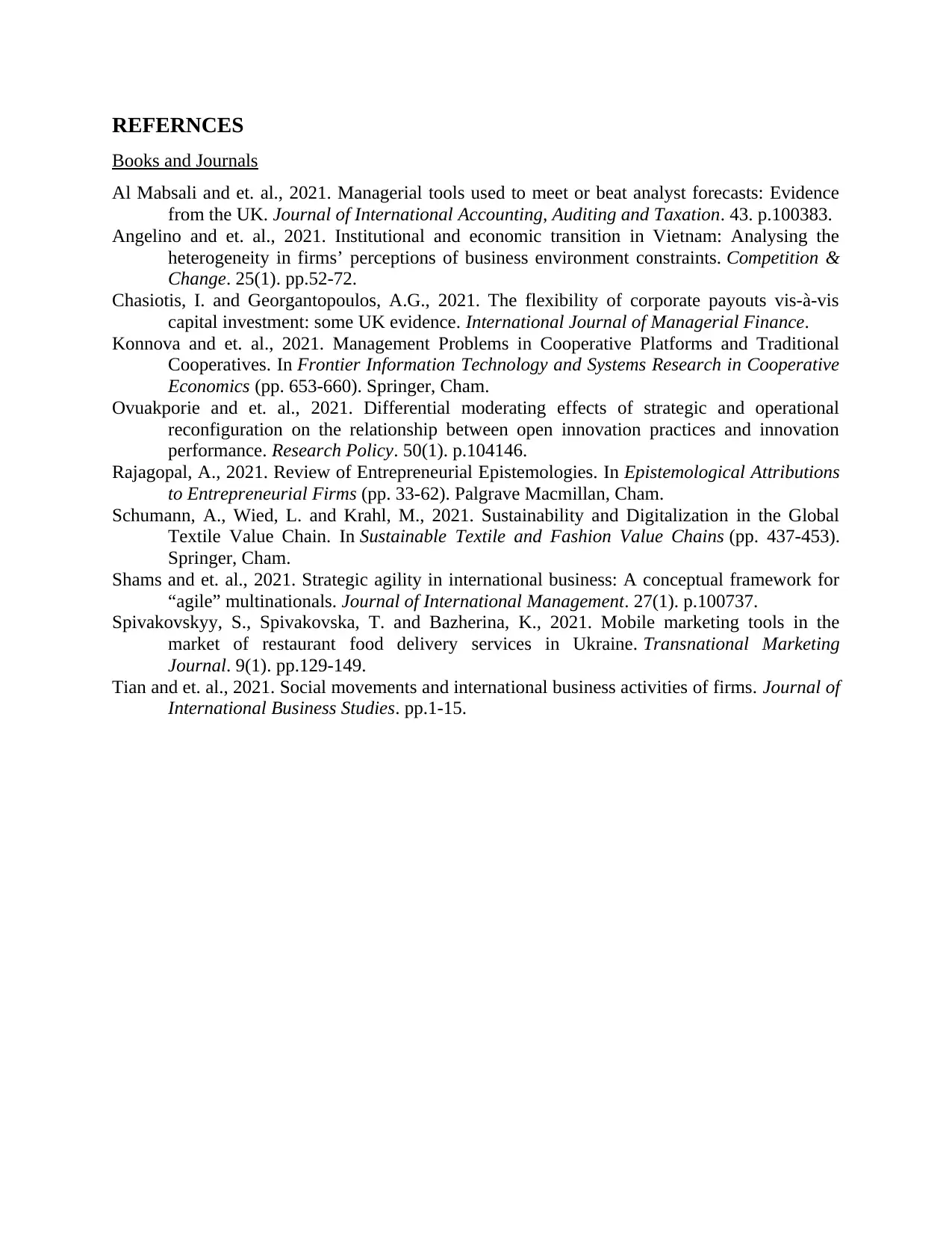
REFERNCES
Books and Journals
Al Mabsali and et. al., 2021. Managerial tools used to meet or beat analyst forecasts: Evidence
from the UK. Journal of International Accounting, Auditing and Taxation. 43. p.100383.
Angelino and et. al., 2021. Institutional and economic transition in Vietnam: Analysing the
heterogeneity in firms’ perceptions of business environment constraints. Competition &
Change. 25(1). pp.52-72.
Chasiotis, I. and Georgantopoulos, A.G., 2021. The flexibility of corporate payouts vis-à-vis
capital investment: some UK evidence. International Journal of Managerial Finance.
Konnova and et. al., 2021. Management Problems in Cooperative Platforms and Traditional
Cooperatives. In Frontier Information Technology and Systems Research in Cooperative
Economics (pp. 653-660). Springer, Cham.
Ovuakporie and et. al., 2021. Differential moderating effects of strategic and operational
reconfiguration on the relationship between open innovation practices and innovation
performance. Research Policy. 50(1). p.104146.
Rajagopal, A., 2021. Review of Entrepreneurial Epistemologies. In Epistemological Attributions
to Entrepreneurial Firms (pp. 33-62). Palgrave Macmillan, Cham.
Schumann, A., Wied, L. and Krahl, M., 2021. Sustainability and Digitalization in the Global
Textile Value Chain. In Sustainable Textile and Fashion Value Chains (pp. 437-453).
Springer, Cham.
Shams and et. al., 2021. Strategic agility in international business: A conceptual framework for
“agile” multinationals. Journal of International Management. 27(1). p.100737.
Spivakovskyy, S., Spivakovska, T. and Bazherina, K., 2021. Mobile marketing tools in the
market of restaurant food delivery services in Ukraine. Transnational Marketing
Journal. 9(1). pp.129-149.
Tian and et. al., 2021. Social movements and international business activities of firms. Journal of
International Business Studies. pp.1-15.
Books and Journals
Al Mabsali and et. al., 2021. Managerial tools used to meet or beat analyst forecasts: Evidence
from the UK. Journal of International Accounting, Auditing and Taxation. 43. p.100383.
Angelino and et. al., 2021. Institutional and economic transition in Vietnam: Analysing the
heterogeneity in firms’ perceptions of business environment constraints. Competition &
Change. 25(1). pp.52-72.
Chasiotis, I. and Georgantopoulos, A.G., 2021. The flexibility of corporate payouts vis-à-vis
capital investment: some UK evidence. International Journal of Managerial Finance.
Konnova and et. al., 2021. Management Problems in Cooperative Platforms and Traditional
Cooperatives. In Frontier Information Technology and Systems Research in Cooperative
Economics (pp. 653-660). Springer, Cham.
Ovuakporie and et. al., 2021. Differential moderating effects of strategic and operational
reconfiguration on the relationship between open innovation practices and innovation
performance. Research Policy. 50(1). p.104146.
Rajagopal, A., 2021. Review of Entrepreneurial Epistemologies. In Epistemological Attributions
to Entrepreneurial Firms (pp. 33-62). Palgrave Macmillan, Cham.
Schumann, A., Wied, L. and Krahl, M., 2021. Sustainability and Digitalization in the Global
Textile Value Chain. In Sustainable Textile and Fashion Value Chains (pp. 437-453).
Springer, Cham.
Shams and et. al., 2021. Strategic agility in international business: A conceptual framework for
“agile” multinationals. Journal of International Management. 27(1). p.100737.
Spivakovskyy, S., Spivakovska, T. and Bazherina, K., 2021. Mobile marketing tools in the
market of restaurant food delivery services in Ukraine. Transnational Marketing
Journal. 9(1). pp.129-149.
Tian and et. al., 2021. Social movements and international business activities of firms. Journal of
International Business Studies. pp.1-15.
⊘ This is a preview!⊘
Do you want full access?
Subscribe today to unlock all pages.

Trusted by 1+ million students worldwide
1 out of 12
Related Documents
Your All-in-One AI-Powered Toolkit for Academic Success.
+13062052269
info@desklib.com
Available 24*7 on WhatsApp / Email
![[object Object]](/_next/static/media/star-bottom.7253800d.svg)
Unlock your academic potential
Copyright © 2020–2025 A2Z Services. All Rights Reserved. Developed and managed by ZUCOL.



